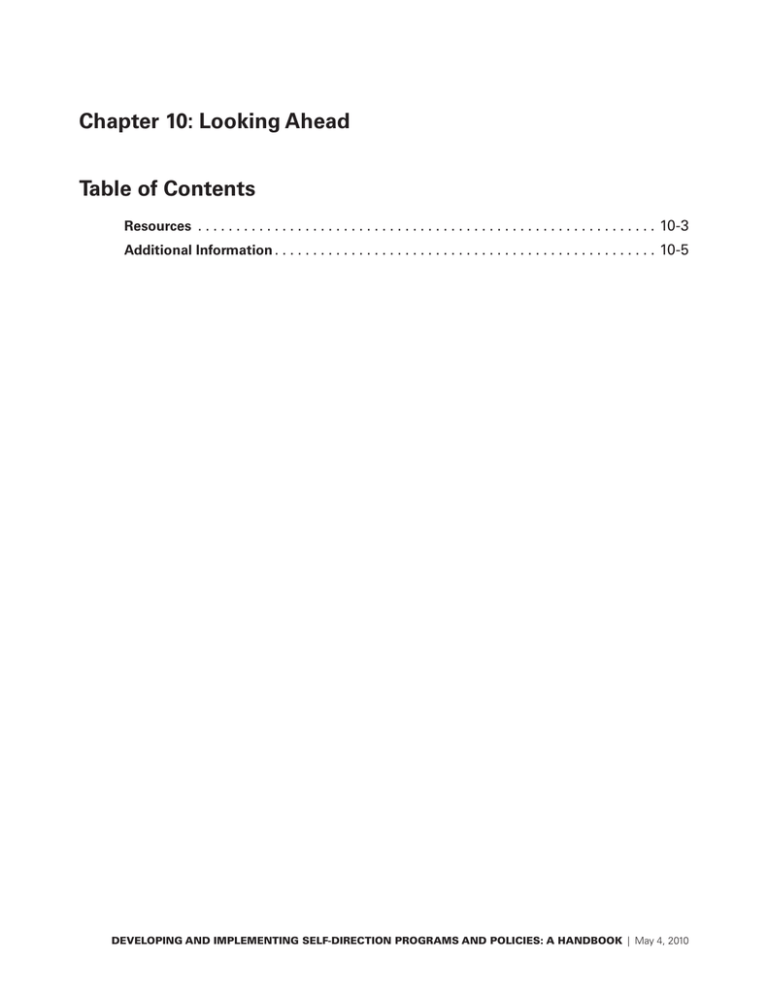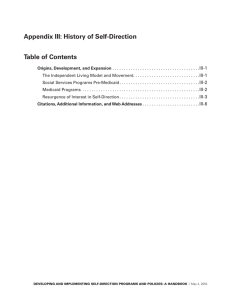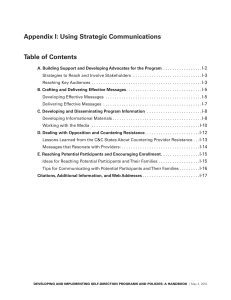Chapter 10: Looking Ahead Table of Contents 10-3 10-5
advertisement

Chapter 10: Looking Ahead Table of Contents Resources������������������������������������������������������������������������������������������������������������������������� 10-3 Additional Information ��������������������������������������������������������������������������������������������������� 10-5 DEVELOPING AND IMPLEMENTING SELF-DIRECTION PROGRAMS AND POLICIES: A HANDBOOK | May 4, 2010 Chapter 10—Looking Ahead 10-1 Chapter 10 Looking Ahead1 Self-direction is now a well-established model of service delivery. While states continue to expand their self-direction programs and develop new ones, they need to be aware of emerging issues that might affect their programs as well as new opportunities to offer participant-directed services. Some components of efforts to increase quality assurance in home and community-based services programs may not be compatible with self-direction programs. For example, self-directing participants define for themselves the employment qualifications their workers need and screen and select among potential workers using these criteria. If training and credentialing requirements for home care workers are mandated to ensure quality, then exceptions may have to be made to ensure that participants in self-direction programs can continue to hire who they want to assist them. Another issue states may need to deal with is unionization. Unionization has resulted in significant wage and benefit increases, most notably in California, Oregon, Washington, and Michigan. In the first three states, union-negotiated contracts with public third party payers have also resulted in health insurance benefits becoming broadly available, for the first time, to participant-directed independent providers. While states may have concerns about the impact of these increases on overall costs, they also need to recognize that these increases offer considerable opportunity to improve and expand the labor pool available to individuals who want to direct their services. Research evidence indicates that wage and benefit improvements (especially the provision of health insurance benefits) increase the pool of workers and, in particular, promote worker retention. However, if workers—including participants’ family members—are required to join a union, participate in mandatory training, and have a criminal background check, for many, the attraction of self-direction may be lost. The relationship between participant-directed services and managed care continues to pose both challenges and opportunities. It remains difficult to predict how much managed care will or will not expand to encompass populations, such as the Medicaid “Aged and Disabled” population and dually eligible (Medicare and Medicaid) population that have traditionally been largely exempt from mandatory enrollment in managed care organizations. If individuals who are directing their services are required to enroll in managed care organizations, states need to ensure that they will be able to continue directing their services. DEVELOPING AND IMPLEMENTING SELF-DIRECTION PROGRAMS AND POLICIES: A HANDBOOK | May 4, 2010 10-2 Finally, there are new opportunities emerging to expand the scope of participantdirected services in terms of both services and constituencies. Several states and one large managed care company operating in several other states have pilot projects that allow Medicaid beneficiaries with mental illnesses to use selfdirected budgets to purchase services (ones that are not otherwise Medicaidcovered) to facilitate and sustain their recovery. The Deficit Reduction Act of 2005 has made available a new State Plan benefit for home and community-based services under Section (§) 1915(i) of Title 19 of the Social Security Act. Because these services are not restricted to individuals who would otherwise be at risk of institutionalization at Medicaid expense, this new benefit opens up possibilities for greatly expanded Medicaid funding of non-institutional psycho-social rehabilitation services for persons with frequently recurring or long-term, persistent mental illnesses.2 The §1915(i) provision specifically authorizes states to offer the covered services through participantdirected service delivery models, at their option. Veterans are another potentially growing constituency for participant-directed services. Ironically, the Veterans Administration pioneered participant-directed long-term care in the U.S. immediately following World War II through a cash benefit—called the aid and attendance allowance—for veterans with severe service connected disabilities. Subsequently, however, the Administration developed a wholly different approach that required Veterans hospitals to be direct providers of services for the much larger population of veterans who developed a need for long-term services and supports long after their military service had been completed. There is an unexpectedly high volume of disabling injuries among recently discharged veterans, including head injuries and stress-related behavioral disorders. The Veterans Administration has recently indicated interest in exploring self-direction for veterans, which could assist the recovery of younger veterans with service-connected disabilities as well as meeting the long-term service and support needs of older veterans. DEVELOPING AND IMPLEMENTING SELF-DIRECTION PROGRAMS AND POLICIES: A HANDBOOK Chapter 10: Looking Ahead | May 4, 2010 10-3 Resources National Resource Center for Participant-Directed Services Web-address: http://www.participantdirection.org Funding for the C&C National Program Office (NPO) ended with the completion of the C&C Replication Project. A new National Resource Center for ParticipantDirected Services has been established to enable other programs to receive the technical assistance the NPO provided to the C&C Grantees—to help them plan, design, implement and evaluate their programs (including help with specific issues such as obtaining workers’ compensation coverage.) The Center is funded by The Robert Wood Johnson Foundation, The Atlantic Philanthropies, the Administration on Aging, and the Office of the Assistant Secretary for Planning and Evaluation, USDHHS. Resources available at the C&C website will remain available and will also be accessible from the new Center’s website. The Consumer Direction Module, a secure web-based software application specifically designed to support self-direction programs that provide individual budgets will also be available through the new Center. The Center provides technical assistance through its staff and affiliated consultants with expertise in specific areas. Technical assistance will be available for all self-direction programs—those that offer only the employer authority as well as those that offer both employer authority and budget authority; Medicaid programs and non-Medicaid programs. Areas in which technical assistance will be available include: financial management services, counselor activities and training, participant involvement, program design and implementation, quality, oversight, and management information systems. The pioneer and replication C&C programs served a variety of target populations including elderly persons and younger adults with adult-onset disabilities (both physical and cognitive), as well as adults and minor children with developmental disabilities, including those with intellectual disabilities only, disabling physical conditions only, or both physical and mental disabilities. The new Center will provide technical assistance for programs serving all of these populations. The Center’s goal is to be the “one-stop shop” for training, technical assistance, research, and policy analysis for programs that want to offer, or are already offering, participant-directed services. The Center is already working with states to promote opportunities for participants to direct their services in programs funded by the the Administration on Aging and the Veterans Administration. One of the Center’s objectives will be to help state officials and advocates/ activists representing the various disability communities understand the DEVELOPING AND IMPLEMENTING SELF-DIRECTION PROGRAMS AND POLICIES: A HANDBOOK Chapter 10: Looking Ahead | May 4, 2010 10-4 similarities and differences that are often obscured by the terminology that has been used to characterize self-direction programs. By pulling back from identification with a particular “brand name” self-direction model (i.e., Cash & Counseling), the Center plans to raise awareness about self-direction generally and assist government officials, as well as advocates and activists, to understand the various program design choices and the pros and cons associated with each of them. For those policymakers and program administrators who want to implement a program that conforms to the C&C Vision Statement (See Chapter One)— even though the program may not use that name—the Center will offer an accreditation program to ensure and grant external recognition that the program fulfills the requirements. Participation in this accreditation program will be strictly voluntary. States and programs that do not seek such accreditation will still be able to obtain technical assistance from the Center in the specific areas with which they need assistance. DEVELOPING AND IMPLEMENTING SELF-DIRECTION PROGRAMS AND POLICIES: A HANDBOOK Chapter 10: Looking Ahead | May 4, 2010 10-5 Additional Information 1 Pamela Doty is the author of this chapter. 2 Most individuals between the ages of 18 and 64 at high risk for admission to state mental hospitals are not eligible for coverage under HCBS waivers because the institutions where they are most likely to receive services are ineligible for Medicaid reimbursement. DEVELOPING AND IMPLEMENTING SELF-DIRECTION PROGRAMS AND POLICIES: A HANDBOOK Chapter 10: Looking Ahead | May 4, 2010







